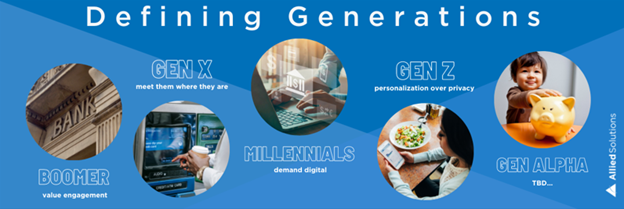SIGN OF THE TIMES BLOG SERIES PART 3 — BANKING FOR THE AGES
What is it about generational banking that creates such a buzz?
Some may weigh in on the challenges presented by the polarization of respective expectations. While others see clear and present opportunity for diversification. Each generation has varying preferences and behaviors. Learning the history behind these generations may impart supportive insights on how to best accommodate each one.

Baby Boomers are a highly populated generation, hence the name. They lived through Vietnam, Watergate, looming threats of nuclear war, and the power struggle between capitalism and communism. Boomers value engagement and are considered an economically influential generation. Financial institutions should seek to understand and elevate their rankings for customer service experience across the board from digital to in-person.
Generation X (Gen X) had a front row seat to computerization and is known for their individualism and entrepreneurialism. Companies like Google, Amazon, and YouTube wouldn’t exist without this generation and made up the majority of responders to 9/11. They know what the world of finance has to offer and are waiting to be met right where they are. They need high-value content delivered by the right channels that support and align with their values.
Millenials (Generation Y) have faced three recessions in their adult lives: the bursting of the Dotcom Bubble, the Great Recession (Global Financial Crisis), and the ever-present turbulence caused by the COVID-19 pandemic. This, combined with rising housing costs and tuition, has stunted this generation’s wealth accumulation thus far. This generation demands digital because, well, they’ve lived with it all their lives.
Generation Z (Gen Z) is only beginning its entry into the workforce. Witnessing historic events, government forgiveness, stimulus checks, and the war in Ukraine - with much more to come. How will this impact their financial literacy and understanding the value of the dollar? Whatever Gen Z receives, it better have their name written all over it – literally and figuratively.
Generation Alpha is the newest to join the ranks and has already been exposed to remote learning, masking in schools, digital currency, supply chain disruptions, and global movements for equality and inclusion all before they’ve reached senior high. Gen Alpha is anticipated to be the most diverse and tech-savvy generation yet. Be on the lookout for immediate gratification and real-time expectations.
Financial institutions should understand how generational trends can provide insights for effective strategies that span both similarities and differences.
Bridging the Gap
First and foremost, consumers want to be heard and accommodated. Despite the labeled generational gaps of today's patrons, financial institutions still exist to offer basic functions like lending and financial protection.
We know lending has undergone extensive developments over the years and financial protection is no longer just about securely storing money once kept under a mattress. The protection canopy has expanded over time bridging the generational gaps through technology and education. Even with numerous innovative financial tools, there’s a great lack of financial literacy.
Financial literacy has taken on modified meanings over time as it continues to be influenced by financial tools and technologies and the economy with their corresponding impacts. Financial education programs improve consumer satisfaction by nurturing meaningful connections for building relationships while offering expertise in a safe and controlled environment. Regardless of age cohort or other demographic factors, consumers are looking to partner with a financial institution that:
- communicates honestly and clearly
- looks out for your best interests
- is accurate and reliable
- shows consumers their business is appreciated, and
- has knowledgeable employees
What can financial institutions do to support the growing expectations of our active generations?
Champion education and technology.
As financial institutions strategize where to invest in future offerings and product development, security services are more likely the safest bet among both younger and older consumers as digital-first strategies continue to boom. Money management tools and virtual assistants should be considered as another opportunity worth exploring, particularly for younger-generation consumers and those willing to dabble in new tech.
View Part 1 here: Sign of the Times Blog Series Part 1: Banking Without Borders
View Part 2 here: Supply Chain Economy: Framework for the Future
Stay Informed with Resources from Allied Solutions: Join our e-newsletter list!
